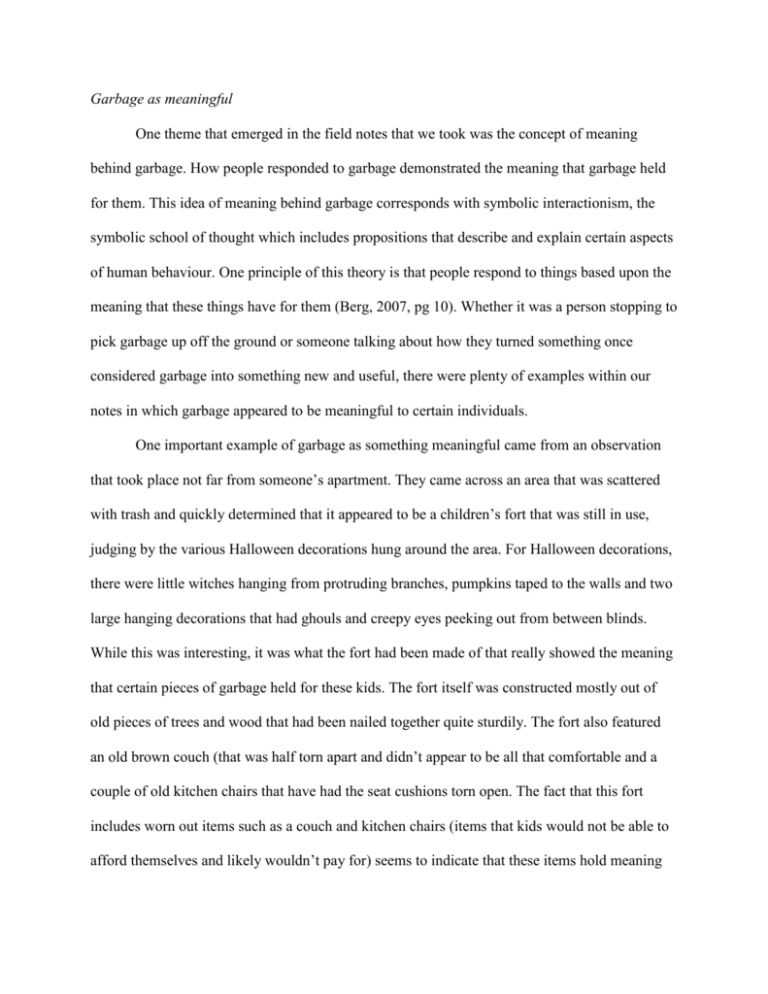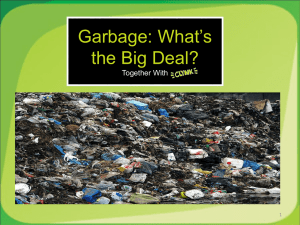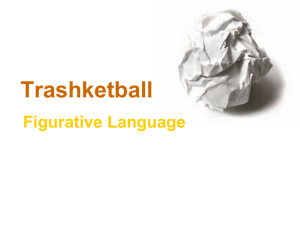Findings- Garbage useful
advertisement

Garbage as meaningful One theme that emerged in the field notes that we took was the concept of meaning behind garbage. How people responded to garbage demonstrated the meaning that garbage held for them. This idea of meaning behind garbage corresponds with symbolic interactionism, the symbolic school of thought which includes propositions that describe and explain certain aspects of human behaviour. One principle of this theory is that people respond to things based upon the meaning that these things have for them (Berg, 2007, pg 10). Whether it was a person stopping to pick garbage up off the ground or someone talking about how they turned something once considered garbage into something new and useful, there were plenty of examples within our notes in which garbage appeared to be meaningful to certain individuals. One important example of garbage as something meaningful came from an observation that took place not far from someone’s apartment. They came across an area that was scattered with trash and quickly determined that it appeared to be a children’s fort that was still in use, judging by the various Halloween decorations hung around the area. For Halloween decorations, there were little witches hanging from protruding branches, pumpkins taped to the walls and two large hanging decorations that had ghouls and creepy eyes peeking out from between blinds. While this was interesting, it was what the fort had been made of that really showed the meaning that certain pieces of garbage held for these kids. The fort itself was constructed mostly out of old pieces of trees and wood that had been nailed together quite sturdily. The fort also featured an old brown couch (that was half torn apart and didn’t appear to be all that comfortable and a couple of old kitchen chairs that have had the seat cushions torn open. The fact that this fort includes worn out items such as a couch and kitchen chairs (items that kids would not be able to afford themselves and likely wouldn’t pay for) seems to indicate that these items hold meaning for them. These items, due to the state they were in and the area they were found, were likely considered to be garbage by someone else. Despite this, the items appear to have held some meaning for the kids who salvaged them and used them within their fort. This is a great example of the saying “one man’s trash is another man’s treasure.” There was another instance given in the field notes where someone had stumbled on what appeared to be a shelter. The shelter was located within a cleared out section of a bush and had been carpeted with many different sized pieces of cardboard and paper that had been flattened down within this two foot area. There was also a lot of garbage in the middle of this bush, including two large Listerine bottles, two small Listerine bottles, an empty Molson Canadian can, several empty packs of cigarettes (from different brands), small plastic bags and two empty personal sized yogurt bottles. While most people would classify these items as garbage and throw them away, the fact that they were near this cleared-out, sheltered area seems to show that these items were of use to someone who frequented this area. Perhaps these items hold some sort meaning to whoever it is that frequents that shelter. Another instance within the field notes where one person’s garbage appeared to be meaningful to someone else arose when one of us was walking around near the dock for the Small Craft Aquatic Centre, when they came across items that may have belonged to a homeless person. There was a pile of items all laying together, which included items such as a full can of Dole pink lemonade, a pair of black pants, a black sweater, a pair of black socks, a dark green tshirt and a blue mug that says “Queen’s Technological College” and bears the Queen’s crest above the text. There was also a Sobeys bag with a greeting card sealed inside of it, a drawstring, two empty orange coloured onion bags and an empty Chapman’s vanilla ice cream container (which was missing the top). There was also a box of sanitary wipes called “Skin Prep” and a box with Ostomy bags; these two items are probably required by the person living in this area. As for the other items (the clothes, the mug, the Sobeys bag with a greeting card, etc.), it would be fairly easy for anyone walking past this area to assume such stuff was garbage left behind by someone, when in all actuality, they probably held a lot of meaning to their owner. Perhaps these are the only possessions owned by this individual, so while they could mean little to nothing to anyone passing by, they could mean the world to their owner. There were also a few instances in which we, the observers, ended up finding items that someone must have considered garbage but that we were able to find meaning in. One example of this came in the form of a multi-tool inside of a belt holder. While investigating the garbage situation on the North side of town, one of us stopped at the Lawrence Amphitheatre Park. As they walked away from a gazebo and towards the woods on a walking trail, they noticed a small item on the ground that looked like a cell phone case. After kicking the case, they realized it was somewhat heavy so they picked it up and realized it was a multi-tool tucked inside of a belt holder. They checked out all of the different things that the tool could be used for (such a pliers, a screwdriver, a knife, a file and scissors) and decided that, because of the good condition the tool was in, they would keep it for themselves. One could think that many others had walked by that same item on the ground and (if they even noticed it) probably assumed it was garbage. This is also an example of another man’s trash becoming another man’s treasure. In another instance, an observer spoke of coming across a Halloween pin on the ground and, due to the closeness of the day, they had picked it up and pinned it on their jacket. This pin would later become a point of discussion between the observer and one of their roommates, in which the meaning of the pin was debated. Considering the observer had picked up not only a pin that day, but a piece of paper with the words “life skills” that had been found on the ground, their roommate made a comment about how they had picked up a fair bit of garbage that day while walking around. The fact that the observer had stopped to pick up these items seems to demonstrate that they held some sort of meaning for them, be it for the sake of humour (picking up a piece of paper that says “life skills” on it for the sake of showing the roommate that they found life skills while walking) or the sake of picking up something that looked to be in good shape (the Halloween pin). The roommate’s dismissal of these items as garbage shows a difference in the meaning that these objects held for these two people- had the roommate been out and about, she wouldn’t have picked up these items but rather walked right past them, treating them like any other piece of litter on the ground. There were a couple of interviews conducted within the field notes that also provided some interesting insight into the meaning that garbage holds for some people. In one case, the person being interviewed was a friend of one of the observers and he spoke about one instance in which he took a piece of a furniture out of a dumpster at his apartment building because he felt the furniture still had value to it. There was a chair sitting in the dumpster that caught his eye one day after he had returned from work and thought to himself that if someone took the time to fix it up that it could be a beautiful piece of restored furniture. This friend took the chair, reupholstered the seat, sanded down and put a new finish on the backrest, shined up the chrome legs of the chair and eventually had a new piece of furniture for his living room. The project, which transformed someone’s garbage into a new piece of furniture for someone else, took a couple of months, during which time he would do a little bit of work here and there on free week nights and weekends. Another interview was conducted with the grandfather of an observer, who was reminded of their grandfather while reading “Empire of Scrounge.” Their grandfather used to be a superintendent in the apartment building in which he lived, as well as a letter carrier for Canada Post, so he would often come across many different things in the dumpster or on the side of the road. When asked about what kinds of things he had found on the side of the road or in the dumpster, he spoke about finding money, a stainless steel lamp in the shape of a boat, wooden window frames, wood, furniture, a portable radio that still worked, a watch, jewellery, books, pop and beer bottles, a six inch black and white TV that had blown a fuse, little fruit bowls, washboards, gloves and much more. Often times, he would give these items away to family or friends (after repairing or restoring them, if need be). He was asked about how he felt about what he was doing and his answer was interesting, stating that he felt like it was his job when it related to him as a superintendent, but as a postal carrier picking up garbage, he felt like a sort of sanitary engineer. When asked about how other people felt about what he was doing, he admitted that his wife (the observer’s grandmother) used to say that she didn’t want “that stuff, any of that junk,” but that she took quite a bit of it anyways. This also shows a bit of a difference in how two people perceive garbage and the meaning it has for them; one person classifies it as junk and would prefer not to have it, while another sees a world of possibility within these items. When asked about which items that he had scrounged held the most meaning to him, or were his favourites, he mentioned the stainless steel boat and an antique globe that he had found. The globe was of interest to him because it so old that some of the countries listed on there are now known by different names, so the globe appears to act as some sort of connection to the past. In any case, this man (through his scrounging, restoring and reusing) serves as an excellent example of someone who sees meaning in the things that most people throw away or walk past, without giving so much as a second thought.







